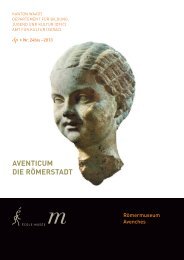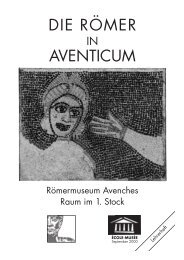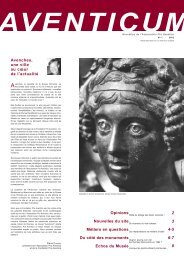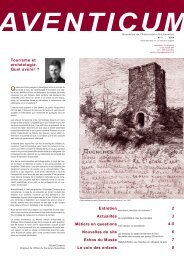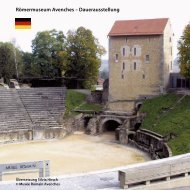Avenches – Roman Museum – Permanent Exhibition
Avenches – Roman Museum – Permanent Exhibition
Avenches – Roman Museum – Permanent Exhibition
You also want an ePaper? Increase the reach of your titles
YUMPU automatically turns print PDFs into web optimized ePapers that Google loves.
Ground Floor The Gallo-<strong>Roman</strong> Population of Switzerland and Their View of Death<br />
The markers for burial places varied considerably: stone or wooden tombstones,<br />
simple stones, small mounds as well as “aedicules” or mausoleums. In most cases<br />
tombstones were engraved with an epitaph and sometimes further decorations<br />
were added. The beginning of the inscription Dis Manibus, often abbreviated to DM,<br />
dedicated a grave to the Manes of the departed or to the spirits of the dead; then<br />
followed the name of the deceased, sometimes his or her filiation, age, profession<br />
or training, honorific titles and, finally, the name of the person who erected the<br />
monument. The deceased was usually represented alone or perhaps accompanied<br />
by his wife or his son; sometimes he was depicted at work. In the <strong>Roman</strong> Empire the<br />
funerary portraits assumed the function of preserving the memory of the deceased.<br />
Some tombstones were decorated with symbols referring to the immortality of<br />
the soul: laurel leaves, birds, celestial bodies. Wealthy people often paid tribute to<br />
their memory by erecting monuments with the statues of the deceased. This can be<br />
seen in the cemetery of En Chaplix. Such monuments were surrounded by gardens,<br />
embellished with statues and sometimes water basins and protected by walls.<br />
The tomb and its surroundings were looked upon as being sacrosanct and holy<br />
and they remained the property of the deceased. The cult of the deceased included<br />
funerary celebrations held at regular intervals on the occasion of the parentalia<br />
(from 13th to 21st February), at which food and drink were given to the dead and<br />
libations (act of pouring out a liquid as a sacrifice) were offered.<br />
Several necropolises are known at Aventicum. The most impressive and richest<br />
of them seems to have been that at the west gate where the remains of several<br />
small funerary chapels, a considerable number of tombstones and the burial place<br />
of a young Christian girl were found. The port necropolis, situated near the lake<br />
and containing approximately forty modest burials, may have been reserved for<br />
the workers in the port. The En Chaplix necropolis, situated beside the road outside<br />
the town at the northeast gate, contained approximately two hundred burials,<br />
which, according to the offerings, must have belonged to people of a higher socioeconomic<br />
standing.<br />
1. Tombstone of Visellia Firma (1)<br />
Erected by her parents. The little girl died aged one year and 50 days.<br />
Limestone. En Chaplix necropolis.<br />
2nd century AD. Catalogue of inscriptions no. 13.<br />
2. Pinecones as tomb decorations<br />
Placed on top of a little mound covering a tomb. Pinecones symbolised immortality.<br />
Limestone. West gate necropolis.<br />
3. Tombstone of Iulia Censorina<br />
Erected by her father.<br />
Limestone. Second quarter of the 1st century AD. Catalogue of inscriptions no. 15.<br />
4. Tombstone of Marcus Alpinius Virilis (2)<br />
Limestone. West gate necropolis.<br />
1st <strong>–</strong> 3rd centuries AD. Catalogue of inscriptions no. 14.<br />
1<br />
2<br />
8<br />
Ground Floor



